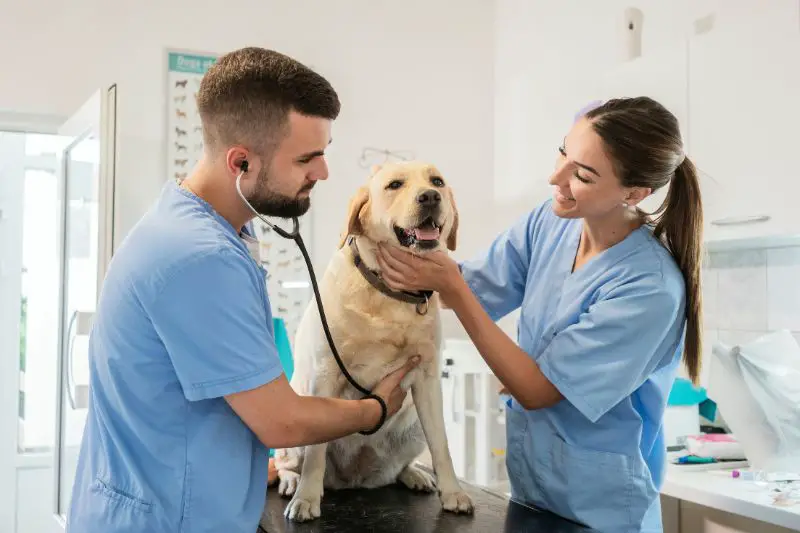
Have you ever wondered why some veterinary clinics are always bustling with clients while others struggle to attract pet owners? It’s not just about offering excellent care—it’s about knowing exactly who needs your services and how to reach them.
Understanding your target market as a veterinarian is the key to building a thriving practice. Whether you serve devoted pet parents, livestock farmers, or equestrian professionals, identifying the right audience helps you tailor your services, marketing efforts, and client experience for maximum impact.
In this article, we’ll dive deep into the key demographics, psychographics, and niche markets that shape the veterinary industry. You’ll also discover practical strategies to connect with your ideal clients and stay ahead of emerging trends. Let’s explore how refining your target market can elevate your veterinary practice to new heights!
What is a Target Market for Veterinarians?

To build a successful veterinary practice, you need more than just medical expertise—you need to understand who your ideal clients are and how to reach them effectively. Your target market is the specific group of people or businesses that require your veterinary services. By defining this market, you can tailor your approach, enhance customer satisfaction, and optimize your marketing efforts.
Why Defining a Target Market Matters
A well-defined target market helps veterinarians:
- Improve Client Acquisition – Focusing on the right audience ensures that your marketing efforts attract the most relevant customers.
- Enhance Service Offerings – Understanding client needs allows you to develop specialized services that align with their expectations.
- Maximize Marketing Efficiency – Targeted messaging leads to higher engagement, better conversion rates, and a stronger return on investment.
- Build Stronger Relationships – A deep understanding of your audience fosters trust and long-term client loyalty.
For example, a veterinarian in an urban setting may primarily serve pet owners with companion animals, while a rural veterinarian might focus on livestock care. Recognizing these distinctions is essential for business growth and sustainability.
Primary Segments in the Veterinary Market
Veterinarians serve a diverse range of clients. While every practice may have a mix of customers, most fall into one or more of the following categories:
1. Pet Owners
Pet owners make up the largest segment of veterinary clients. This group includes individuals and families with dogs, cats, birds, reptiles, and exotic pets.
- Trends to Consider: The rise of pet humanization means many owners now view pets as family members, increasing demand for premium veterinary care, specialized treatments, and wellness services.
- Marketing Tip: Leverage social media, pet-focused content marketing, and local partnerships to attract and engage pet owners.
2. Livestock Farmers
Farmers and ranchers require veterinary care for livestock such as cattle, pigs, sheep, and poultry. These clients prioritize disease prevention, reproductive health, and regulatory compliance.
- Key Challenges: Farmers often seek cost-effective, large-scale solutions rather than individualized pet care.
- Marketing Tip: Offering mobile veterinary services and working with agricultural organizations can help build strong relationships within this segment.
3. Equestrian Owners and Trainers
Horse breeders, competitive riders, and equestrian trainers rely on veterinary expertise for performance enhancement, injury prevention, and rehabilitation.
- Specialized Services: Equine veterinarians often provide orthopedic care, dental health, and nutrition plans tailored to high-performance horses.
- Marketing Tip: Sponsoring equestrian events and networking with riding clubs can strengthen visibility among this niche market.
4. Wildlife and Conservation Organizations
Zoos, wildlife rehabilitation centers, and conservation groups require veterinarians with expertise in exotic and endangered species.
- Unique Requirements: Wildlife care demands specialized knowledge, often involving collaboration with researchers and government agencies.
- Marketing Tip: Establishing partnerships with environmental organizations can create opportunities in this specialized field.
5. Government Agencies and Research Institutions
Veterinarians working in public health, food safety, and disease control often collaborate with government entities and research institutions.
- Role in Society: These veterinarians play a crucial role in preventing zoonotic diseases, ensuring food safety, and advancing scientific research.
- Marketing Tip: Gaining certifications in veterinary public health and networking within academic and regulatory communities can open doors in this sector.
How to Identify Your Ideal Target Market
If you’re unsure which segment best aligns with your practice, ask yourself the following questions:
- What type of clients currently make up the majority of my business?
- Which services generate the highest demand in my area?
- Are there underserved markets that I can tap into?
- How do local demographics influence veterinary service needs?
Key Demographics of Veterinary Clients

Understanding the demographics of veterinary clients allows you to tailor your services and marketing strategies to the right audience. By analyzing factors such as age, location, income, and pet ownership trends, you can identify the most profitable and sustainable client base for your practice.
Age and Pet Ownership Trends
Pet ownership varies significantly across different age groups, influencing the type of veterinary care in demand.
- Millennials (25-40 years old) – This generation represents the largest segment of pet owners, with 32% of pet ownership in the U.S. (American Pet Products Association). They are highly engaged in pet wellness, preventive care, and alternative treatments.
- Generation X (41-56 years old) – Typically established professionals or families, Gen X pet owners prioritize comprehensive medical care, including diagnostics and specialized treatments.
- Baby Boomers (57-75 years old) – Many in this group own pets for companionship. They often seek long-term care plans and geriatric pet services.
Insight: Veterinary practices should consider targeted marketing strategies that align with each group’s priorities, such as wellness plans for millennials or senior pet care programs for older owners.
Urban vs. Rural Veterinary Needs
Geographic location plays a significant role in shaping veterinary services.
- Urban Areas – Clinics in cities primarily serve companion animal owners who seek preventive care, emergency services, and specialized treatments. Demand for luxury pet services, such as acupuncture and physical therapy, is rising.
- Suburban Areas – Suburban veterinarians often see a mix of family pet owners and small-scale farm animal caretakers. This market benefits from flexible, community-oriented services.
- Rural Areas – Rural veterinary practices cater to livestock, equestrian clients, and mixed-animal care. Mobile veterinary services are highly valuable in these regions.
Example: A veterinarian in New York City may invest in state-of-the-art diagnostic equipment to cater to high-income pet owners, while a rural veterinarian in Texas might focus on large-animal ambulatory services.
Income Levels and Spending on Veterinary Care
A client’s financial situation directly impacts their willingness to invest in veterinary services.
- High-Income Households – Pet owners with greater financial resources are more likely to opt for advanced treatments, pet insurance, and specialized care. Veterinary practices in affluent areas should highlight premium services such as orthopedic surgery, dental care, and wellness packages.
- Middle-Income Households – This group represents the majority of pet owners. They seek quality yet affordable care, making payment plans, wellness packages, and preventive services highly attractive.
- Low-Income Households – Clients with limited financial resources often struggle to afford veterinary care. Practices that offer low-cost vaccination clinics, partnerships with animal welfare organizations, or sliding-scale fees can effectively serve this segment.
Data Point: According to the American Pet Products Association, U.S. pet owners spent over $37 billion on veterinary care in 2023, highlighting the increasing demand for diverse service offerings at various price points.
Pet Ownership by Household Type
Veterinary clients differ based on their living situation and lifestyle.
- Single Professionals – Often seek convenient, tech-enabled veterinary care, such as telemedicine consultations and mobile services.
- Families with Children – Prioritize comprehensive, long-term pet health plans and educational resources on pet care.
- Senior Citizens – Frequently own companion animals and require accessible, home-based veterinary options for aging pets.
Psychographics: Understanding Customer Needs and Behaviors

Demographics tell you who your clients are, but psychographics reveal why they seek veterinary care and how they make decisions. By understanding pet owners’ values, lifestyles, and emotional connections to their animals, you can refine your services and marketing approach to better resonate with their needs.
The Emotional Bond Between Owners and Their Pets
For many pet owners, animals are more than just companions—they are family. This emotional attachment directly influences how clients approach veterinary care.
- High-Involvement Pet Owners – These clients prioritize their pet’s well-being and are willing to invest in preventive care, premium treatments, and alternative therapies. They often research extensively and seek second opinions.
- Practical Pet Owners – This group values quality care but is more cost-conscious, focusing on necessary treatments, vaccinations, and basic wellness services.
- Casual Pet Owners – These clients may only visit a veterinarian for urgent issues or mandatory vaccinations. They require education and engagement strategies to encourage preventive care.
Example: A veterinarian targeting high-involvement pet owners may offer wellness plans with routine checkups, dental care, and holistic treatments, while those serving practical owners might focus on cost-effective vaccination packages and essential services.
Motivations for Seeking Veterinary Care
Clients choose veterinary services based on a combination of emotional, financial, and practical factors. Understanding these motivations helps tailor communication and service offerings.
- Preventive and Wellness Care – Many owners prioritize routine exams, vaccinations, and parasite control to ensure long-term pet health. Marketing these services as essential for early disease detection and cost savings can be effective.
- Emergency and Critical Care – Urgent medical issues often drive emotionally charged, high-stakes decisions. Clear communication, transparency in pricing, and compassionate support are critical in these situations.
- Specialty Services and Advanced Treatments – Some pet owners seek oncology, dermatology, or rehabilitation therapies for chronic conditions. Providing educational content about these services helps attract and retain these clients.
Insight: Educating pet owners about the long-term benefits of preventive care through blogs, social media, and in-office consultations can shift behaviors and increase client retention.
Lifestyle Factors That Influence Veterinary Decisions
A client’s lifestyle significantly impacts their expectations for veterinary care.
- Busy Professionals – Value convenience and efficiency, making online appointment booking, telehealth services, and extended hours attractive.
- Families with Multiple Pets – Seek cost-effective solutions, such as bundled services and multi-pet wellness plans.
- Senior Pet Owners – May require home visit options or assistance with pet transportation.
Example: A veterinarian in a metropolitan area might introduce mobile veterinary services to accommodate busy pet owners, while a rural practice could offer on-site farm visits for livestock care.
The Growing Demand for Ethical and Holistic Veterinary Care
Modern pet owners are becoming more conscious of ethical and holistic approaches to animal health.
- Sustainable and Eco-Friendly Practices – Many clients prefer organic pet food, chemical-free treatments, and environmentally friendly clinics.
- Alternative and Holistic Therapies – Services like acupuncture, herbal medicine, and physiotherapy are gaining popularity among wellness-focused pet owners.
Marketing Tip: Highlighting sustainable practices, cruelty-free products, or holistic treatment options in promotional materials can help attract ethically minded pet owners.
How to Leverage Psychographics in Your Veterinary Practice
To align your services with customer behaviors, consider the following strategies:
- Develop Client Personas – Create detailed profiles of your ideal customers, including their values, concerns, and decision-making processes.
- Personalize Communication – Use targeted email campaigns, social media engagement, and tailored in-clinic experiences to connect with different client segments.
- Offer Tiered Service Options – Provide a range of basic, mid-tier, and premium services to cater to varying client needs and budgets.
Niche Markets for Veterinarians

While general veterinary practices serve a broad range of clients, niche markets offer opportunities for specialization, differentiation, and increased profitability. By focusing on specific client needs or unique animal populations, veterinarians can attract loyal customers, reduce competition, and establish themselves as experts in their field.
1. Mobile Veterinary Services
With increasing demand for convenience, mobile veterinary care has become a sought-after service. This model allows veterinarians to treat pets in their own homes, reducing stress for both animals and owners.
- Target Clients: Busy professionals, elderly pet owners, multi-pet households, and rural communities.
- Key Services: Routine checkups, vaccinations, minor procedures, end-of-life care.
- Market Insight: According to industry reports, mobile vet practices have lower overhead costs and offer greater flexibility, making them an attractive business model for solo practitioners.
2. Exotic and Small Mammal Veterinary Care
Many pet owners struggle to find veterinarians experienced in treating birds, reptiles, rabbits, ferrets, and other exotic pets. Specializing in this niche can position a practice as a go-to resource for unique animal care.
- Target Clients: Exotic pet enthusiasts, breeders, and zoological organizations.
- Key Services: Specialized diagnostics, nutritional counseling, habitat recommendations, and surgical care.
- Market Insight: The exotic pet market is growing, with an increasing number of households adopting non-traditional pets. Veterinarians with expertise in exotic medicine can attract a highly dedicated client base.
3. Sports Medicine and Rehabilitation for Animals
Performance animals, including racehorses, agility dogs, and working animals, require specialized care to prevent injuries, enhance performance, and support recovery.
- Target Clients: Equestrian professionals, dog agility trainers, service animal handlers.
- Key Services: Physical therapy, hydrotherapy, acupuncture, regenerative medicine.
- Market Insight: With the rise of holistic and alternative therapies, veterinary sports medicine is a lucrative niche, offering both traditional and integrative treatment options.
4. Holistic and Integrative Veterinary Medicine
Holistic veterinary care focuses on natural and alternative therapies to complement traditional treatments. This approach appeals to pet owners seeking wellness-focused and drug-free solutions.
- Target Clients: Owners interested in organic, non-invasive treatment options.
- Key Services: Acupuncture, herbal medicine, chiropractic care, homeopathy.
- Market Insight: Pet owners are increasingly turning to holistic medicine, with a growing number seeking alternative treatments for chronic conditions and pain management.
5. Veterinary Dentistry
Dental health is a major but often overlooked aspect of animal care. Specializing in veterinary dentistry can differentiate a practice and improve overall pet health outcomes.
- Target Clients: Companion pet owners, senior pet caretakers, and breeders.
- Key Services: Cleanings, extractions, orthodontics, and periodontal disease management.
- Market Insight: Studies show that 80% of dogs and 70% of cats develop dental disease by age three, creating high demand for professional veterinary dentistry.
6. End-of-Life and Palliative Care Services
Providing compassionate hospice and euthanasia services allows veterinarians to support pet owners through difficult decisions while ensuring pets experience dignified, pain-free care.
- Target Clients: Senior pet owners, individuals with terminally ill pets.
- Key Services: Pain management, home euthanasia, grief counseling.
- Market Insight: The demand for pet hospice care is increasing, with more owners seeking comfort-focused end-of-life services for their animals.
7. Food Animal and Large-Scale Livestock Veterinary Services
Veterinarians specializing in food production animals play a crucial role in disease prevention, herd management, and food safety.
- Target Clients: Farmers, ranchers, agricultural businesses.
- Key Services: Herd health management, reproductive services, regulatory compliance.
- Market Insight: As global demand for animal protein rises, the need for skilled livestock veterinarians continues to grow, making this a stable and essential veterinary niche.
8. Shelter and Rescue Veterinary Care
Animal shelters and rescue organizations require dedicated veterinarians to provide affordable medical care, spay/neuter services, and rehabilitation for rescued animals.
- Target Clients: Nonprofit shelters, rescue groups, animal welfare organizations.
- Key Services: High-volume spay/neuter programs, vaccinations, disease management.
- Market Insight: Many municipal and nonprofit shelters seek long-term veterinary partnerships, creating opportunities for contract-based or subsidized veterinary services.
9. Corporate and Research Veterinary Roles
Veterinarians with expertise in research, pharmaceuticals, and public health contribute to scientific advancements, disease prevention, and food safety regulations.
- Target Clients: Biotech firms, government agencies, academic institutions.
- Key Services: Vaccine development, drug testing, epidemiological research.
- Market Insight: The veterinary pharmaceutical industry is valued at over $40 billion globally, highlighting significant opportunities in research and development.
Choosing the Right Niche for Your Veterinary Practice
Selecting a veterinary niche should align with:
- Your expertise and interests – Choosing a niche you’re passionate about increases long-term satisfaction and success.
- Market demand in your area – Assess local client needs and gaps in available services.
- Profitability and sustainability – Consider the financial viability and scalability of the niche.
How Veterinarians Can Reach Their Target Market

Reaching the right clients is essential for a successful veterinary practice. By leveraging effective marketing strategies, community engagement, and technology, veterinarians can attract and retain loyal customers. Here’s how to connect with your ideal audience.
1. Develop a Strong Online Presence
A well-optimized digital presence helps veterinarians increase visibility and build credibility.
Optimize Your Website
Your website should be user-friendly, mobile-responsive, and informative. Key elements include:
- Clear service descriptions – Outline available treatments and specialties.
- Online appointment booking – Offer convenience for tech-savvy pet owners.
- Educational content – Publish blogs on pet health topics to build trust and authority.
Utilize Search Engine Optimization (SEO)
Optimizing your website for local searches ensures your practice appears when potential clients look for veterinary services.
- Use location-based keywords (e.g., “veterinarian in [city]”).
- Encourage Google Reviews to improve search rankings.
- List your practice on Google Business Profile for increased visibility.
Leverage Social Media Marketing
Social media is a powerful tool for engaging pet owners and building a community.
- Post valuable content – Share pet care tips, success stories, and client testimonials.
- Engage with followers – Respond to comments and messages to build relationships.
- Run targeted ads – Use Facebook and Instagram ads to reach specific demographics.
2. Build Relationships with the Local Community
Establishing trust within the local community helps veterinarians grow their client base.
Partner with Pet-Related Businesses
Collaborate with groomers, pet stores, trainers, and shelters to cross-promote services. Consider:
- Referral programs – Offer discounts to clients referred by partner businesses.
- Joint events – Host adoption days or pet wellness workshops together.
Attend and Sponsor Local Events
Visibility at farmers’ markets, pet expos, and charity runs increases brand recognition. Offer:
- Free pet checkups or wellness consultations.
- Educational talks on pet health and preventive care.
Offer Community Outreach Programs
Engage with the community by providing low-cost vaccination clinics, school presentations, or animal welfare initiatives.
3. Use Client-Centered Marketing Strategies
Understanding your clients’ needs and tailoring marketing efforts helps build long-term relationships.
Develop a Client Loyalty Program
Encourage repeat visits with rewards for:
- Routine checkups and vaccinations.
- Referrals to friends and family.
- Long-term memberships for preventive care plans.
Personalized Email and SMS Marketing
Use targeted messaging to keep clients informed and engaged.
- Appointment reminders reduce missed visits.
- Pet health newsletters educate and add value.
- Seasonal promotions (e.g., flea and tick prevention) encourage preventive care.
4. Leverage Online Reviews and Testimonials
Positive reviews build trust and attract new clients.
- Ask satisfied clients to leave reviews on Google, Yelp, and Facebook.
- Showcase testimonials on your website and social media.
- Respond to reviews professionally to demonstrate excellent customer service.
5. Invest in Paid Advertising
If competition is high, strategic paid ads can increase visibility and drive client acquisition.
Google Ads
Appear at the top of search results when pet owners look for veterinary services in your area.
- Use geo-targeting to focus on your service area.
- Bid on high-intent keywords like “emergency vet near me.”
Social Media Ads
Platforms like Facebook and Instagram allow precise targeting based on pet ownership, location, and interests.
- Create visually appealing ads featuring happy pets and satisfied clients.
- Offer limited-time discounts on first visits to encourage new clients.
6. Provide Exceptional Customer Service
Word-of-mouth referrals are one of the most powerful marketing tools. Happy clients are more likely to recommend your practice.
- Ensure short wait times and efficient service.
- Train staff to be friendly and compassionate.
- Follow up with clients after appointments to show you care.
Conclusion
Reaching the right target market is essential for veterinary success. By combining a strong online presence, local community engagement, and client-centered marketing strategies, veterinarians can effectively attract and retain loyal clients.
A well-optimized website, social media engagement, and SEO-focused content ensure visibility, while partnerships with local pet-related businesses and community outreach efforts build trust. Personalized client interactions, loyalty programs, and exceptional customer service further enhance relationships and encourage referrals.
